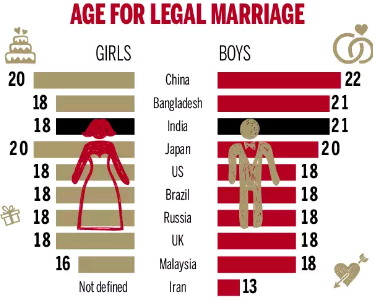Why is age of marriage different for men and women? 27/08/2019 – Posted in: Daily News – Tags: Committee on the Elimination of Discrimination against Women
DIFFERENT MARRIAGE AGE FOR MEN AND WOMEN
For: Mains
Topics covered:
- Why is the age of marriage different for men and women?
- How the law evolved?
- Why different ages?
- Challenge in Court
News Flash
The Delhi High Court took up a plea that sought a uniform age of marriage for men and women.
- Currently, the law prescribes that the minimum age of marriage is 21 for men and 18 years of women.
- The minimum age of marriage is distinct from the age of majority, which is gender-neutral.
- An individual attains the age of majority at 18 as per the Indian Majority Act, 1875.
Why a minimum age?
- The law prescribes a minimum age of marriage to essentially outlaw child marriages and prevent abuse of minors.
- Personal laws of various religions that deal with marriage have their own standards, often reflecting custom.
- For Hindus, Section 5(iii) of the Hindu Marriage Act, 1955 sets 18 years as the minimum age for the bride and 21 years as the minimum age for the groom.
- Child marriages are not illegal but can be declared void at the request of the minor in the marriage.
- In Islam, the marriage of a minor who has attained puberty is considered valid under personal law.
- The Special Marriage Act, 1954 and the Prohibition of Child Marriage Act, 2006 also prescribe 18 and 21 years as the minimum age of consent for marriage for women and men respectively.
How the law evolved?
- The Indian Penal Code enacted in 1860 criminalised any sexual intercourse with a girl below the age of 10.
- The provision of rape was amended in 1927 through the Age of Consent Bill, 1927, which made marriages with a girl under 12 invalids.
- In 1929, the Child Marriage Restraint Act set 16 and 18 years as the minimum age of marriage for women and men respectively.
- The law, popularly known as Sarda Act after its sponsor Harbilas Sarda, a judge and a member of Arya Samaj, was eventually amended in 1978 to prescribe 18 and 21 years as the age of marriage for a woman and a man, respectively.
Why different ages?
- The different legal standards for the age of men and women to marry has been a subject of debate.
- In a consultation paper of reform in family law in 2018, the Law Commission argued that having different legal standards “contributes to the stereotype that wives must be younger than their husbands”.
- Women’s rights activists have argued that the law perpetuates the stereotype that women are more mature than men of the same age and therefore can be allowed to marry sooner.
- The international treaty Committee on the Elimination of Discrimination against Women (CEDAW), also calls for the abolition of laws that assume women have a different physical or intellectual rate of growth than men.
- The Law Commission paper recommended that the minimum age of marriage for both genders be set at 18.
Challenge in court?
The petitioner in the Delhi high court has alleged that Articles 14 and 21 of the Constitution, which guarantee the right to equality and the right to live with dignity, are violated by having different legal age for men and women to marry.
Related judgments
In 2014, in National Legal Services Authority of India v Union of India, the Supreme Court while recognising transgenders as the third gender said that justice is delivered with the “assumption that humans have equal value and should, therefore, be treated as equal, as well as by equal laws.”
In 2019, in Joseph Shine v Union of India, the Supreme Court decriminalised adultery and said that “a law that treats women differently based on gender stereotypes is an affront to women’s dignity.”
Source: Indian Express
ALSO, READ MORE DAILY NEWS
- The validity of the Triple Talaq law
- Gulbarga tur dal gets GI tag
- National Food Laboratory
- Kutch desert was once a forest
You are on the Best Online IAS preparation platform. You are learning under experts.
We are present on Facebook- Diligent IAS, LinkedIn- Diligent IAS, YouTube- Diligent IAS, Instagram- Diligent IAS. Get in touch with us.

